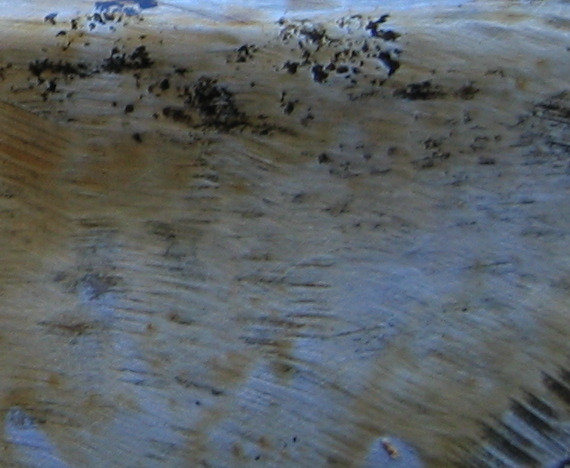Rust Converter on:
[Wikipedia]
[Google]
[Amazon]
Rust converters are chemical solutions or primers that can be applied directly to an iron or iron alloy surface to convert iron oxides (

"The Conservation of Two Cast Iron Bells at the Lac Qui Parle Mission Historic Site" (PDF, 131 kB)
Coatings Corrosion prevention Metal plating Metalworking
rust
Rust is an iron oxide, a usually reddish-brown oxide formed by the reaction of iron and oxygen in the catalytic presence of water or air moisture. Rust consists of hydrous iron(III) oxides (Fe2O3·nH2O) and iron(III) oxide-hydroxide (FeO(OH ...
) into a protective chemical barrier. These compounds interact with iron oxides, especially iron(III) oxide
Iron(III) oxide or ferric oxide is the inorganic compound with the formula Fe2O3. It is one of the three main oxides of iron, the other two being iron(II) oxide (FeO), which is rare; and iron(II,III) oxide (Fe3O4), which also occurs naturally ...
, converting them into an adherent black layer (black oxide
Black oxide or blackening is a conversion coating for ferrous materials, stainless steel, copper and copper based alloys, zinc, powdered metals, and silver solder. It is used to add mild corrosion resistance, for appearance, and to minimize light ...
) that is more resistant to moisture and protects the surface from further corrosion
Corrosion is a natural process that converts a refined metal into a more chemically stable oxide. It is the gradual deterioration of materials (usually a metal) by chemical or electrochemical reaction with their environment. Corrosion engine ...
. They are sometimes referred to as "rust remover" or "rust killer".
Typical ingredients
Commercial rust converters are water-based and contain two primary active ingredients:tannic acid
Tannic acid is a specific form of tannin, a type of polyphenol. Its weak acidity ( pKa around 6) is due to the numerous phenol groups in the structure. The chemical formula for commercial tannic acid is often given as C76H52O46, which correspon ...
and an organic polymer
A polymer (; Greek '' poly-'', "many" + ''-mer'', "part")
is a substance or material consisting of very large molecules called macromolecules, composed of many repeating subunits. Due to their broad spectrum of properties, both synthetic a ...
. Tannic acid chemically converts the reddish iron oxides into bluish-black ferric tannate, a more stable material. The second active ingredient is an organic solvent such as 2-butoxyethanol
2-Butoxyethanol is an organic compound with the chemical formula BuOC2H4OH (Bu = CH3CH2CH2CH2). This colorless liquid has a sweet, ether-like odor, as it derives from the family of glycol ethers, and is a butyl ether of ethylene glycol. As a rela ...
(ethylene glycol monobutyl ether, trade name butyl cellosolve) that acts as a wetting agent and provides a protective primer layer in conjunction with an organic polymer emulsion.
Some rust converters may contain additional acids to speed up the chemical reaction by lowering the pH of the solution. A common example is phosphoric acid
Phosphoric acid (orthophosphoric acid, monophosphoric acid or phosphoric(V) acid) is a colorless, odorless phosphorus-containing solid, and inorganic compound with the chemical formula . It is commonly encountered as an 85% aqueous solution, w ...
, which additionally converts some iron oxide into an inert layer of ferric phosphate
Iron(III) phosphate, also ferric phosphate, is the inorganic compound with the formula Fe PO4. Several related materials are known, including four polymorphs of FePO4 and two polymorphs of the dihydrate FePO4·(H2O)2. These materials find fe ...
. Most of the rust converters contain special additives. They support the rust transformation and improve the wetting of the surface.
Uses
Rust converter is usually applied to objects that are difficult to sand blast, such as vehicles, trailers, fences, iron railings, sheet metal, and the outside of storage tanks. It may also be used to restore and preserve iron-based items of historical importance.See also
*Bluing (steel)
Bluing is a passivation process in which steel is partially protected against rust using a black oxide coating. It is named after the blue-black appearance of the resulting protective finish. Bluing involves an electrochemical conversion coati ...
*Phosphate conversion coating
Phosphate conversion coating is a chemical treatment applied to steel parts that creates a thin adhering layer of iron, zinc, or manganese phosphates, to achieve corrosion resistance, lubrication, or as a foundation for subsequent coatings or pai ...
*Parkerizing
Phosphate conversion coating is a chemical treatment applied to steel parts that creates a thin adhering layer of iron, zinc, or manganese phosphates, to achieve corrosion resistance, lubrication, or as a foundation for subsequent coatings or p ...
References
{{ReflistExternal links
"The Conservation of Two Cast Iron Bells at the Lac Qui Parle Mission Historic Site" (PDF, 131 kB)
Coatings Corrosion prevention Metal plating Metalworking